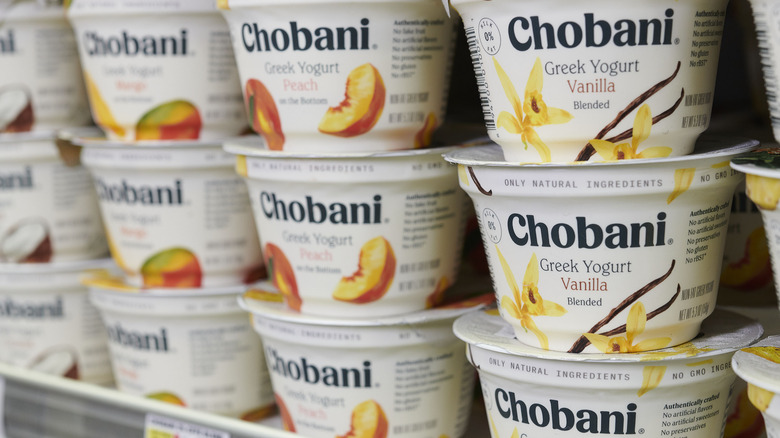You Won't Be Able To Guess How Yogurt Was Invented
We may receive a commission on purchases made from links.
Many favorite and popular foods were invented by accident. This includes corn flakes, brownies, and blue cheese, along with, yes, yogurt. However, the popular dessert wasn't the happy result of a scientist leaving an experimental mixture out overnight or a home cook throwing together the wrong ingredients in the kitchen. Instead, yogurt's origins are a little less palatable.
According to the BBC, Bulgarians claim that nomadic tribes invented yogurt completely by accident approximately 4,000 years ago. Tribe members stored milk in animal skins, a dark and warm bacteria-laden environment that was perfect for cultivating yogurt. The food quickly became a staple in the Bulgarian diet.
Some accounts differ, saying yogurt was mentioned in Indian Ayurvedic scripts as far back as 6000 BCE. But many agree that it was the Bulgarians that brought yogurt to the world's stage (via Nutrition Reviews). It was Bulgarian scientist Dr. Stamen Grigorov who discovered the specific bacteria required for yogurt production (Lactobacillus bulgaricus) in 1905 and named it after his countrymen. That same year, Grigorov's colleague, Elie Metchnikoff, stated that Bulgarians achieved greater life longevity due to the bacteria found in their yogurt-heavy diets. Quickly, yogurt became a popular food throughout Europe and the United States, touted for its medicinal properties (via BC Dairy).
How is yogurt made today?
While yogurt's accidental beginnings can be supposedly traced back to some lucky nomad throwing some milk in animal skin and calling it a day, we've come a long way from fermenting our yogurt in preserved animal skins and stomachs (via MSN). However, while the animal stomachs are out, the same basic principles still apply. Yogurt requires bacteria, milk, and a warm environment.
Today, according to HowStuffWorks, manufacturers simply separate milk into skim and cream, thicken the resulting milk product, and then heat the milk to pasteurize it. From there, the bacteria is manually added into the warm milk and left to ferment, after which sugar or fruit can be added. You can make your yogurt at home using the same process, only on a much smaller scale. MasterClass offers a step-by-step tutorial on making your yogurt, and you won't even need to harvest animal stomach to ferment it.

